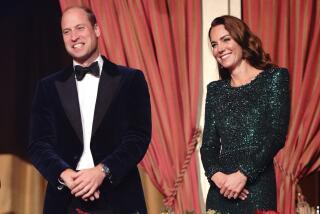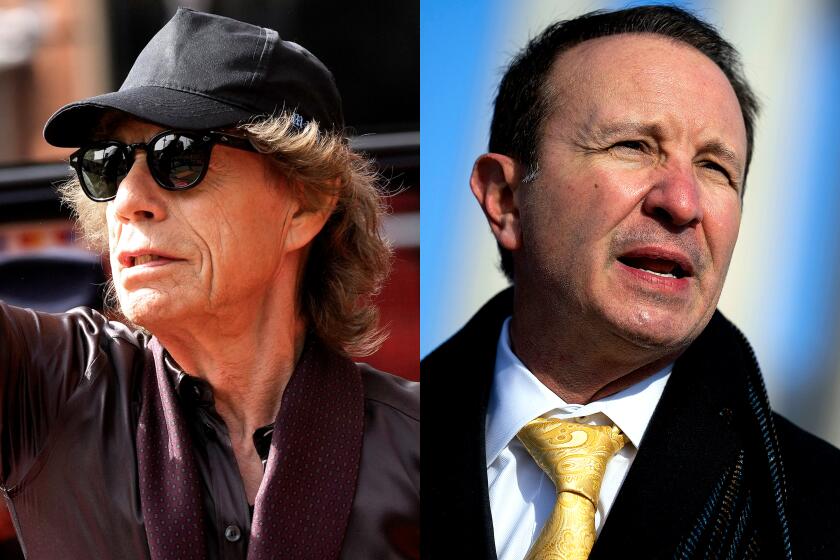Plugging Into a Legend
He considered himself a simple repairman but sparked an international revolution. A half-century ago, self-effacing Leo Fender began perfecting electric guitars in his Fullerton factory. His Telecasters, Stratocasters and electric basses changed the sound of popular music and were integral to the birth of rock ‘n’ roll.
The Fullerton Museum Center opens an exhibition honoring its hometown hero Sunday titled “A Shower of Brilliance: Leo Fender and His Electric Guitars.” The title came from Fender himself, who used it to describe the sound he heard from a local guitarist trying out one of his new instruments in the 1980s.
The show, which runs through January 2003, is part of a larger effort by the center to establish a permanent gallery dedicated to the man and the instruments. It includes many items from a 1993 Fender exhibition that was one of the Fullerton center’s most popular shows ever--including the very first electric guitar Fender built--plus a few pieces on loan specifically for the new show. Beyond the guitars and amplifiers, it includes revealing historical items such as a 1951 invoice showing the line-by-line price of parts and labor for building a Telecaster. Total cost: $27.87.
Fullerton Museum Center Director Joe Felz discussed the show and the center’s efforts to remember the legacy of Fender, who died in 1991.
Question: The 1993 Fender exhibition was an exhaustive, authoritative look at the man and his guitars. Why are you doing another one?
Answer: In some ways this is the same show because that last exhibit was comprehensive. It was extremely popular, and the community interest in Leo is quite high. People still ask us about that show. In fact, I remember about a year and a half after it closed, this family on vacation from France drove down here one day--from San Francisco. They tapped on the back door--it was on a Monday and the center was closed--and a teenage boy and his mom were standing there, he had his Fender guitar in the back seat of their car and a copy of an article about the show in the French version of Guitar Player magazine. It was their current issue, but the show had been closed for 18 months. I felt so bad--I gave them a copy of the catalog from the show, and a T-shirt and anything else I could find. But it had that kind of appeal.
Q: What’s different about the new show?
A: It doesn’t have a lot of the mechanical kinds of stuff that was in the other show. This one captures his work as a creator more than anything else. . . . In addition, when we track attendance it will help us assess the interest level and potential attendance for a permanent gallery.
Q: Any interesting new Fender finds?
A: There’s an old radio made by the Fender Radio Service [the company Fender ran before he started making electric guitars]. It’s one of the first, and they’re amazingly rare, so that’s pretty cool to get an object that tells the very beginnings of the story. . . . We also have what may be the first Stratocaster ever made. It’s serial No. 100, and Fender production runs often started at No. 100, but we’re not certain if it’s the first.
Q: Wouldn’t a permanent Fender gallery in Fullerton conflict with the Fender Museum of Music and the Arts that the current Fender Musical Instrument Corp. set up in Corona?
A: From the start when we got this idea we did not want to be in a competitive situation. Their mission is to tell the story of how the current owners bought the company from CBS in the ‘80s and turned it around, and what they’re doing now. Ours would be to tell the story of Leo Fender, and what he did until he sold the company to CBS in 1965. So they’re happy to let us tell that part of the story. In that way, we can complement each other rather than compete.
Q: What’s the status of the expansion project?
A: We’re just about to finish the feasibility study. We’re looking at comparable museums and we want to know the truth. Maybe the answer will come back that nobody’s interested and nobody would attend. We don’t want to hear just what somebody thinks we want to hear.
Q: What’s the biggest challenge about the prospect of adding a permanent gallery and creating a permanent collection?
A: It’s becoming a collecting museum. We’re used to getting things on loan from other museums and from private collectors, and we have a pretty good reputation. But this whole world of collecting is something entirely different, especially when you are going after instruments that can sell for $250,000 or $500,000. That’s a bit scary.
*
* “A Shower of Brilliance: Leo Fender and His Electric Guitars” opens Sunday at the Fullerton Museum Center, 301 N. Pomona Ave., Fullerton. Ends January 2003. $3, general; $2, students; $1, children 6 to 12; free for children under 12. A reception and concert will be held at the center on Saturday at 5 p.m. $20. (714) 738-6545.
More to Read
The biggest entertainment stories
Get our big stories about Hollywood, film, television, music, arts, culture and more right in your inbox as soon as they publish.
You may occasionally receive promotional content from the Los Angeles Times.






